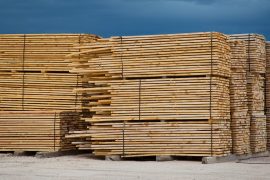Have you ever wondered why does wood float on water, while rocks and fine sand grains fall into the water and sink?
There is a simple answer to this question: since the wood has a lower density than water, it floats on it.
Well, that’s the right answer, but it’s not perfect at all. There are other points.
Have you ever wondered how a large ship could move on the water without drowning? How does a metal boat stay floating on the water, but an iron rod drowns? Have you ever thought about it? 🙂
The reason for these phenomena is the Buoyancy force. Stay with us.
Buoyancy Force

Imagine swimming in the pool. You might have felt that when you go deep into the depths, Moving down will be harder. In a simple word the force that the fluid applies to the immersed object is called Buoyancy force.
Buoyancy is an upward force exerted by a fluid that opposes the weight of an immersed object.
Lichtenberg Wood Burning eBook

Download Lichtenberg Wood Burning eBook
One of the modern techniques for creating wooden artwork is called Lichtenberg wood Burning. In this eBook, we are going to introduce this newfound art to you.
This technique is known with some different names such as Lichtenberg wood burning, fractal wood burning, and electricity wood art.
This technique should not be confused with wood burning art or pyrography. The art of pyrography on wood is the art of creating motifs and designs by burning with hot metal tools on objects such as wooden surfaces.
Lichtenberg burning is a wood-burning technique for creating designs with electricity.
This eBook is a comprehensive guide on Lichtenberg Wood Burning. All you need to know for Lichtenberg Wood Burning is here.
This is a limited-time offer, order now to get access to the future eBook releases.
When an object falls into water, as much as the volume of that object, water will be displacing.
In this case, the Buoyancy force is equal to the weight of the water displaced. This is, in fact, the Archimedes’ principle known since ancient Greece.
One Simple Experiment
Choose a stone piece. And hang it from a scales and write down the mass. Now in the same state immerse it in a bucket of water and read it again on the scale. The difference between the two masses is equal to the displaced water mass.
Why Does Wood Float on Water?
If the Buoyancy force is equal to the weight of an object, it will be floating on the water.
Notice that the weight or size of an object is not important here. If you put one fine sand grain in the water, it sinks in water because the displaced water weight is much less than the weight of the grains.
But a piece of wood stays floating on the water because the Buoyancy force is equal to the weight of the wood.
It does not matter what the size of the wood is. What matters is density.
What is Density?

The density is the same as the ratio of mass per unit volume of a substance. Mathematically, density is defined as the amount of mass divided by volume:
D = M/V
The Relationship Between Density and the Buoyancy of an Object in the Water
There is an inverse relationship between the density and buoyancy of an object.
If the density of an object is less than the density of water, the floating force applied by the water will be greater than the object weight, and therefore the object will remain floating on the water.
Comparing the Density of Wood and Water

Typically, wood has a lower density than water. Especially when it is completely dry. Wood is a solid material and often with a density below 1 g / cm3 (1000 kg / m3). See what is wood made of.
Below are some examples of the density of wood types in the dry state:
- Walnut wood (650 kg/m³)
- Oakwood 900 (kg/m³)
- Pinewood 600 (kg/m³)
- Spruce wood 600 (kg/m³)
- Alder wood 500 (kg/m³)
- Ash wood 700 (kg/m³)
Compare this with water density of around 997 kg/m³. Of course, there are exceptions, and there are also some wood species that if placed in the water, will sink into it. now you find that why does wood float on water?
Woods With a Higher Density Than Water
Here is a list of some wood species that have a higher density than water.
- Greenheart (1040 kg/m³)
- Mountain Mahogany (1100 kg/m³)
- Ebony wood (1200 kg/m³)
- Desert Ironwood (1150 kg/m³)
- Lignum Vitae (1260 kg/m³)
- Cocobolo wood (1095 kg/m³)
Any wood that has a density greater than water will sink. Metals like steel, which are seven times the density of water, will surely drown in water. But there is an interesting question. What causes the huge metal ships float on the water?
Why Metal Ship Does Float on the Water?

The density of the carbon steel is 7850 kg/m³. But despite this, the steel ship does not sink on the water. This is because the ship is mostly composed of air, not the metal!
So, if we consider the volume of air inside the ship, the average density of the ship is much less than that of the water.
For example, if a boat weighs 1,000 kilograms, it sinks somewhere in the water to move 1,000 kilograms of water.
If the boat can move 1,000 kilograms of water before it falls underwater, it can then be floated and will not sink.
Doing this is not very hard. The special shape of the ship and boats (like a bowl) makes the boat filling a lot of air. Therefore, the average boat density (the combination of air and steel) is less than water.
Conclusion
In this article, we gave a complete answer to the question of why wood does float on the water. You see, this goes back to the relationship between density and Buoyancy of wood. So, we can get a general answer:
The density of the wood is less than water, which makes the applied Buoyancy force by water more than the weight force of the wood. That’s why the wood does float.
You also saw in this article that there are woods that have a higher density than water. But the same wood can also be used to build a boat.
The shape of the boats brings down the average density to a lower amount of the water itself, because of the air inside it.







Comments
Pingback: What is the Aquarium Wood? | Wood Dad
Pingback: Natural Wood Colors Chart - Wood Dad
Pingback: A Piece Of Wood Floats On Water? 90 Most Correct Answers